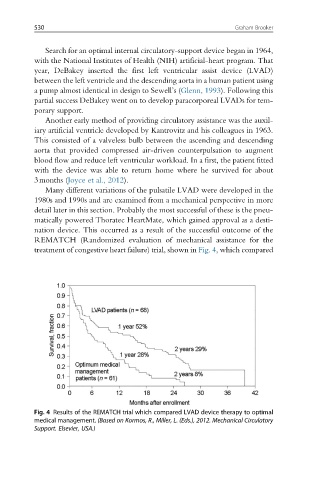Page 536 - Handbook of Biomechatronics
P. 536
530 Graham Brooker
Search for an optimal internal circulatory-support device began in 1964,
with the National Institutes of Health (NIH) artificial-heart program. That
year, DeBakey inserted the first left ventricular assist device (LVAD)
between the left ventricle and the descending aorta in a human patient using
a pump almost identical in design to Sewell’s (Glenn, 1993). Following this
partial success DeBakey went on to develop paracorporeal LVADs for tem-
porary support.
Another early method of providing circulatory assistance was the auxil-
iary artificial ventricle developed by Kantrovitz and his colleagues in 1963.
This consisted of a valveless bulb between the ascending and descending
aorta that provided compressed air-driven counterpulsation to augment
blood flow and reduce left ventricular workload. In a first, the patient fitted
with the device was able to return home where he survived for about
3months (Joyce et al., 2012).
Many different variations of the pulsatile LVAD were developed in the
1980s and 1990s and are examined from a mechanical perspective in more
detail later in this section. Probably the most successful of these is the pneu-
matically powered Thoratec HeartMate, which gained approval as a desti-
nation device. This occurred as a result of the successful outcome of the
REMATCH (Randomized evaluation of mechanical assistance for the
treatment of congestive heart failure) trial, shown in Fig. 4, which compared
Fig. 4 Results of the REMATCH trial which compared LVAD device therapy to optimal
medical management. (Based on Kormos, R., Miller, L. (Eds.), 2012. Mechanical Circulatory
Support. Elsevier, USA.)

